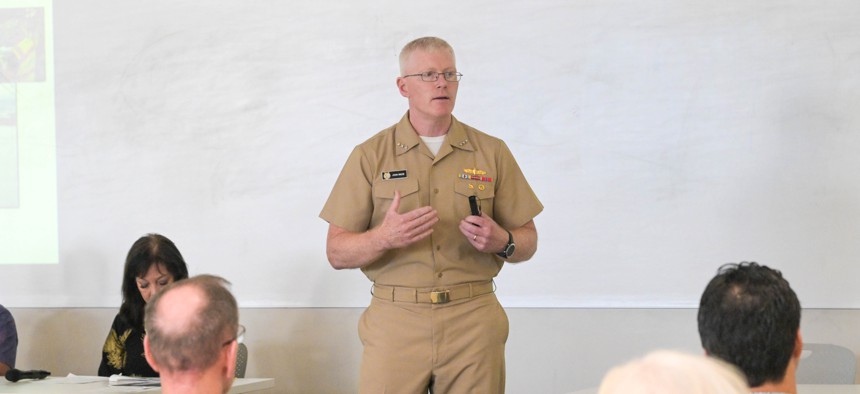
Joint Task Force Red-Hill Commander Vice Adm. John Wade provides a defueling update to the Military Affairs Council of the Hawaii Chamber of Commerce in Honolulu, Hawaii, March. 1, 2024. U.S. Army / Sgt. ZaBarr Jones
With Red Hill’s tanks virtually empty, closure task force begins work
The redistribution of fuel to locations around the Pacific “will really make us safer,” commander says.
FORD ISLAND, Hawaii—The process of removing more than 104 million gallons of fuel from the bulk storage facility at Red Hill has revealed lessons that apply across the Department of Defense, the commander of Joint Task Force Red Hill told Defense One this week.
Fuel spills in 2021 from the massive facility contaminated the drinking water of tens of thousands of people. Defense Secretary Lloyd Austin in March 2022 announced that the military would defuel and close Red Hill, and the defueling began in October 2023.
That part of the mission ended Thursday, when JTF-Red Hill commander Vice Adm. John Wade passed control of Red Hill to the new Navy Closure Task Force. The turnover is “a continuity and continuation of the same difficult mission,” U.S. Indo-Pacific Command head Adm. John Aquilino said at the ceremony, held aboard a World War II battleship.
In an interview, Wade said about 28,000 gallons of sludge and roughly 4,000 gallons of trapped fuel remain; the closure task force will remove that fuel, clean the tanks, decommission the facility, and complete environmental remediation.
Wade was selected for the job from his position as director of operations at INDOPACOM. His first challenge, at least on the technical side, was that “nothing like this has ever been done before,” he said.
“Fuel companies have certainly closed and defueled and decommissioned facilities, but none of this magnitude, but not inside of a mountain, 100 feet above the aquifer,” Wade said.
Another challenge: Initially, there was no single officer in charge of safety and security. Wade’s mission was expanded to take centralized control of the facility, and that responsibility passed Thursday to the commander of the closure task force, Rear Adm. Stephen Barnett. And the lessons have made their way to Austin’s office, where officials are looking more broadly at the issue of command and control in similar situations.
After all, Wade said, in many ways, Red Hill “is not unlike other fuel depots across the entire DOD enterprise. There’s maintenance that needs to be done. There’s modernization efforts, there’s funding, there’s safety, there’s operations, there’s training, there’s certifications, there’s environmental preparedness and response… So we have provided recommendations and feedback up through my chain of command. And it’s not only with fuel, it’s also with hazardous materials. Ensuring proper risk mitigations are in place, that procedures are updated, not only to prevent a potential mishap, but then to adequately respond effectively and fast.”
The millions of gallons of fuel removed from Red Hill was redistributed across multiple locations: San Diego, Singapore, the Philippines, a commercial facility in western Oahu, and some above-ground tanks at Joint Base Pearl Harbor-Hickam.
In Austin’s 2022 letter announcing the defueling and closure of Red Hill, he wrote that having a centralized bulk fuel storage facility “likely made sense in 1943… but it makes a lot less sense now.”
Wade echoed those remarks.
“As the former [INDOPACOM operations officer] and as a senior joint and naval officer… the relocation of the fuel will really make us safer. Because now, instead of the fuel in one location, it’s distributed in multiple nodes, it gives us greater agility and flexibility to deter and prevent conflict, and then to be more ready to respond in a crisis or a contingency,” he said.
During the Thursday ceremony, Barnett pledged to “continue the healing process” for the people of Hawaii.
“For more than 80 years, the facility has kept our ships sailing, has kept our aircraft flying,” he said. “It’s enabled the United States of America to safeguard our nation and its most important assets,” he said. “But it’s time for us to move to the next phase. … This will take a tremendous amount of hard work… but we’re ready.”
